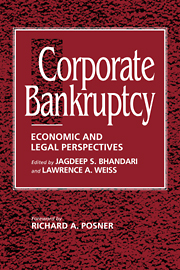Book contents
- Frontmatter
- Contents
- List of tables and figures
- Foreword by the HONORABLE RICHARD A. POSNER
- Preface
- Part I The role of credit
- Part II Bankruptcy as a reflection of the creditors' implicit bargain
- Part III Beyond the basic creditors' bargain
- Part IV Workouts or bargaining in the shadow of bankruptcy
- Part V Alternatives to bankruptcy and the creditors' bargain
- Part VI Experience of other countries
- 29 Lessons from a comparison of U.S. and U.K. insolvency codes
- 30 The costs of corporate bankruptcy: A U.S.–European comparison
- 31 Should we abolish Chapter 11? The evidence from Japan
- 32 The role of banks in reducing the costs of financial distress in Japan
- Index
30 - The costs of corporate bankruptcy: A U.S.–European comparison
Published online by Cambridge University Press: 10 December 2009
- Frontmatter
- Contents
- List of tables and figures
- Foreword by the HONORABLE RICHARD A. POSNER
- Preface
- Part I The role of credit
- Part II Bankruptcy as a reflection of the creditors' implicit bargain
- Part III Beyond the basic creditors' bargain
- Part IV Workouts or bargaining in the shadow of bankruptcy
- Part V Alternatives to bankruptcy and the creditors' bargain
- Part VI Experience of other countries
- 29 Lessons from a comparison of U.S. and U.K. insolvency codes
- 30 The costs of corporate bankruptcy: A U.S.–European comparison
- 31 Should we abolish Chapter 11? The evidence from Japan
- 32 The role of banks in reducing the costs of financial distress in Japan
- Index
Summary
Both Britain and France have adopted new bankruptcy/insolvency laws since 1985 and a new bankruptcy law has also been proposed in Germany, although not yet adopted. In all three countries, a major purpose of the new laws is to shift the focus of bankruptcy law away from exclusively protecting creditors' interests and toward a balance between protecting creditors versus saving distressed firms. However, many of the features of bankruptcy law differ in the three countries and all three countries' bankruptcy laws differ quite strongly from bankruptcy law in the United States. This chapter has several purposes. First, basic differences between bankruptcy laws in the four countries are identified and compared. Second, the costs (losses in economic efficiency) attributable to bankruptcy are identified. Bankruptcy costs are shown to occur at three different times: before it is known whether individual firms will be financially distressed, after firms have become financially distressed but before they file for bankruptcy, and after firms file for bankruptcy. Third, the costs of bankruptcy under the laws of the four countries, as well as under various proposed bankruptcy reforms, are analyzed.
The major conclusion of the chapter is that bankruptcy costs incurred before it is known whether firms will be financially distressed are likely to be much more important determinants of whether bankruptcy policy is economically efficient than bankruptcy costs incurred after firms have become financially distressed and/or after they have filed for bankruptcy.
- Type
- Chapter
- Information
- Corporate BankruptcyEconomic and Legal Perspectives, pp. 467 - 500Publisher: Cambridge University PressPrint publication year: 1996
- 37
- Cited by



